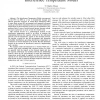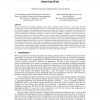416 search results - page 66 / 84 » Modeling and analysis of dynamic coscheduling in parallel an... |
INFOCOM
2007
IEEE
14 years 3 months ago
2007
IEEE
— The Interference Temperature Model was proposed by the FCC in 2003 as a way to dynamically manage and allocate spectrum resources. It would allow unlicensed radios to sense the...
IPPS
2003
IEEE
14 years 2 months ago
2003
IEEE
Component-based models represent a dominant trend in the construction of wide-area network applications, making possible the integration of diverse functionality contained in modu...
CONCURRENCY
2006
13 years 8 months ago
2006
: The next generation of scientific experiments and studies, popularly called e-Science, is carried out by large collaborations of researchers distributed around the world engaged ...
HPDC
2008
IEEE
13 years 9 months ago
2008
IEEE
Abstract-The analysis of data usage in a large set of real traces from a high-energy physics collaboration revealed the existence of an emergent grouping of files that we coined &q...
DSN
2006
IEEE
14 years 14 days ago
2006
IEEE
Distributed sensor networks are highly prone to accidental errors and malicious activities, owing to their limited resources and tight interaction with the environment. Yet only a...


